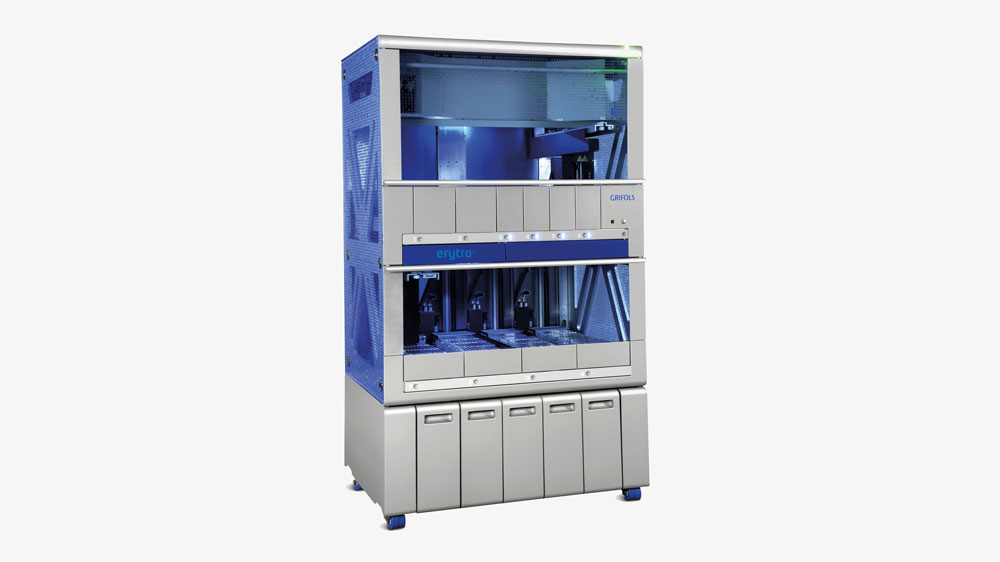Grifols Erytra: Implementation of a New Blood Bank Automated System at Duke Regional Hospital
Duke Regional Hospital, Durham, NC

Introduction
Duke Regional Hospital is one of the three hospitals comprising the Duke University Health System. With 360 beds and over 500 dedicated physician staff members, Duke Regional Hospital is a Level 3 trauma center that provides the Durham, NC, community every possible medical service in a convenient community hospital environment. Patients at Duke Regional Hospital have access to Duke University Health System expertise, including a Level 1 trauma center, burn care, and transplant service, located at the affiliated Duke University Hospital nearby.
Background
Debie Lynn DeCrescenzo, laboratory supervisor of transfusion services, joined the Duke University Health System in late 2015 with an immediate need to update the laboratory's aging blood bank automation, which had been in use at Duke Regional Hospital for over 12 years. Debie's previous experience managing multiple blood banks (and more recently working as a consultant in Texas) meant that Duke Regional Hospital had vast experience in the first generation of automated blood bank platforms. "I had a very good idea of what instrumentation I wanted to pursue before arriving at Duke," explains Debie.
Solution
After performing extensive research on new automation, Duke Regional Hospital identified that they needed to move to a gel-based, cost-effective solution that could meet their services' testing needs. Duke Regional Hospital, along with their affiliate Duke Raleigh Hospital, standardized their pretransfusion testing by selecting the Grifols Erytra as the next generation of automation for their transfusion services at both sites.
The Erytra Key Attributes

Advantages:
Flexibility for different lab configurations
Scalability with Erytra Eflexis and manual stations
Very quiet: 45 dBA
Optimizes STAT sample management
Small footprint: 43" x 28" x 69" (w x d x h)
Features:
Capacity: Up to 400 cards
Sample loading capacity: up to 96
Throughput: T&S 48 samples/hr (3 cell screen)
Learn more about Erytra
Results
Grifols Erytra Impact on Productivity at Duke Regional Hospital
In the fall of 2016, immediately prior to the delivery of the Grifols Erytra, Duke Regional Hospital lost a blood bank technician to another department at Duke University Health System, with no option to replace the headcount. Staff at Duke Regional Hospital initially had reservations about the extra workload. Although additional stress was placed on the transfusion service throughout the installation and validation of the Erytra, once go live occurred, several features of the Erytra allowed Duke Regional Hospital to streamline their workflow. The net effect from the loss of headcount was absorbed and, simultaneously, Duke Regional Hospital reduced turnaround time for blood bank testing and increased throughput (see Table 1).
One area the Erytra had an enormous impact on at Duke Regional Hospital was patient care, specifically with oncology and dialysis patients. "Since the Erytra replaced our prior system at Duke Regional Hospital, blood products are now available to these patients within 40 minutes or less. Previously this was 70 minutes," stresses Debie. When laboratory testing reveals these patients require transfusion, Duke Regional Hospital reports that patients will not need to make an extra trip to the hospital, and providers are happy that their patients leave the clinic without symptomatic anemia or other health concerns.

DG Gel Detected Antibodies Previously Not Detected
Duke Regional Hospital reports that validation of the Erytra was exceedingly straightforward. Each validation specimen was tested on the Erytra using DG Gel and reagents. On the previous system, each was tested using the lab's current gel and reagents. In addition, samples were tested in manual tube and manual gel using both the lab's current gel and Grifols DG Gel. "We performed this massive validation and obtained 100% concordance," explains Debie. "Surprisingly, we had a few specimens where Grifols reagents detected antibodies previously not detected in evidence."
During validation, Duke Regional Hospital reported that low-frequency antibodies anti-Kpa, anti-Lua, and anti-Cw were detected using Grifols DG Gel system, but had not been detected during initial antibody screenings. The blood bank staff at Duke Regional Hospital identified Grifols reagent red cells to be the key in detecting these low frequency antibodies. Debie states, "Initial antibody screenings had not detected these antibodies because the screening cells we'd been using didn't encompass these antigens. It's nice to have a clear, clinical picture."
Partnership Drives Laboratory Efficiencies
Purchasing, installing, and validating a new analyzer is a large undertaking for laboratories. Selecting the right partner—beyond just reagents and automation—is also very important. "I've purchased many different pieces of equipment, but this is the first time where a company helped us organize absolutely everything," Debie states. Grifols project management allowed Duke Regional Hospital to streamline training, validation, procedure generation, and optimize standing orders.
“Physicians in both of these departments were extremely happy when we were able to routinely begin delivering blood at the time of need & not the following day”
Blood product availability
- Prior system
-
60-90 minutes
- Erytra
-
40 minutes
Efficiency: comparison
- Prior system
-
First sample of 12 T&S still pending at 29 minutes
- Erytra
-
12 T&S completed in 29 ½ minutes
Loading
- Prior system
-
Batching of samples required
- Erytra
-
Continual loading possible shortening turn-around times
STAT
- Prior system
-
Routine sample interruption
- Erytra
-
No process interruption
Wash buffer
- Prior system
-
Prepare frequently
- Erytra
-
Prepare once a day — the analyzer can hold much larger volumes
Reagent wastage - RBCs
- Prior system
-
High for red cells
- Erytra
-
Probe is able to aspirate the last drop of red cells due to the tilted block holding the reagent red cell vials
| Features | Prior system | Erytra |
|---|---|---|
|
Blood product availability |
60-90 minutes |
40 minutes |
|
Efficiency: comparison |
First sample of 12 T&S still pending at 29 minutes |
12 T&S completed in 29 ½ minutes |
|
Loading |
Batching of samples required |
Continual loading possible shortening turn-around times |
|
STAT |
Routine sample interruption |
No process interruption |
|
Wash buffer |
Prepare frequently |
Prepare once a day — the analyzer can hold much larger volumes |
|
Reagent wastage - RBCs |
High for red cells |
Probe is able to aspirate the last drop of red cells due to the tilted block holding the reagent red cell vials |